Disclosure: My dog blog is supported by dog parents just like you. I only recommend products that I would use on my dogs. All opinions expressed here are my own. I sometimes earn a small affiliate commission, at no extra cost to you, when you click through the affiliate link and purchase something. You can read more about my affiliate policy here.
Hippity hoppity Easter’s on its way. In less than a week to be exact! And, as a dog parent planning festivities, there are Easter hazards for pets you should be aware of.
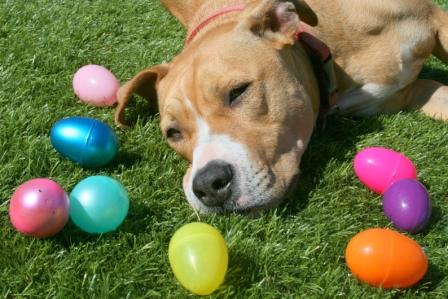
Easter 2020 will appear somewhat different this year with social distancing due to the coronavirus pandemic. As a result, there will not be any community or church egg hunts to attend.
Therefore, following social distancing recommendations, we will spend Easter at home with only family members who live there. However, a pandemic will not keep the Easter bunny from arriving.
And along with the Easter bunny comes baskets filled with goodies. Plus, Easter egg hunts will take place in backyards.
For dog parents, it’s what’s in the baskets and eggs that can pose Easter hazards for pets. But, that’s not all that can threaten your fur baby’s safety at Easter.
5 Easter Hazards for Pets to Avoid
As much fun as this holiday can bring, we do need to know how to keep our doggos safe. Therefore, we need to know what the five main Easter hazards for pets are.
Those five main dangers that pose a threat to dogs at Easter are:
- Chocolate
- Plastic Easter grass (filler)
- Candy and gum containing xylitol
- Fatty foods
- Lilies
Easter is a time when you may bring different items into your home, like chocolate candies in foil wrappers, poisonous plants, and plastic objects, like eggs, toys, and synthetic grass, which can be dangerous if ingested by your pet.
Dr. Brittin Ross, spcaLA director of Veterinary Services.
Keeping potentially dangerous items out of your pet’s reach is the best way to ensure his safety during the holiday, Ross says.
Chocolate
Why is it that the Animal Poison Control Center typically receives the most chocolate intoxication calls during Easter? I mean, Christmas, Valentine’s Day and Halloween, all bring chocolate for celebrating.

It probably has to do with candy hidden around the house or the yard that was never found. Likewise, unattended Easter baskets can be another culprit. Dogs are great at sniffing out chocolate, because they have a sweet tooth. And they can’t stop eating it once they start.
Therefore, it is best to ensure that all candy is out of reach of pets at all times. Especially chocolate, because all types of it pose a danger for your fur baby.
The substance, theobromine is found in chocolate and it causes an extreme reaction and sometimes death.
Following are symptoms a dog may display after consuming chocolate:
- Internal bleeding
- Irregular heartbeat
- Seizures
- Muscle tremors
- Diarrhea
- Vomiting
- Heart attack
If you suspect or know your dog has eaten chocolate, call your veterinarian right away.
Candy and Gum Containing Xylitol

In addition, it is best to keep your dog away from any hard candy or jelly beans, as well. A lot of candies contain xylitol, an artificial sweetener, which is highly toxic to pets.
But it’s not just candy, xylitol can be found in gum, peanut butter, and alcohol, among other things. Preventive Vet has created a 700+ product list containing xylitol. The list is separated into categories making it easy to navigate. Check out the list here.
Some signs that your dog has consumed something containing xylitol include:
- Weakness or lethargy
- Walking drunk
- Depression
- Acute collapse
- Seizures
- Vomiting
- Racing heart rate
- Trembling or tremoring
- Jaundiced gums
- Diarrhea
- Black-tarry stool
- Bruising
- Clotting problems
- Abnormal mentation (thinking or any work of the mind)
- Loss of motor control
So, if you suspect your dog has ingested a product containing xylitol, immediately contact your veterinarian. However, you can also take him to an animal emergency room, or contact the APCC. Most of all, don’t wait!
Plastic Easter Grass (Filler)

When decorating for Easter, that brightly colored plastic stuff called Easter grass or filler is used. As a result, it makes the Easter baskets look more festive and brightens up kitchen tables.
However, this festive decoration is also very appealing to dogs. And being the curious creatures they are, when dogs get into it, bad things can happen.
Firstly, it can be a choking hazard. But, if a dog happens to get it swallowed, then it can cause some serious internal problems. The Easter grass can bunch up in your doggo’s digestive system, since it can’t be digested.
Therefore, it can cause intestinal blockages, which can require surgery to remove the clump of plastic grass.
Play it safe and opt for a safer and more eco-friendly option. That is to say, consider switching out the plastic Easter grass with paper Easter grass. The paper version comes in bright, festive colors, as well.
Fatty Foods
Oh! The yummy smell of ham cooking for Easter lunch or dinner is very tantalizing for your fur baby. But, no matter how much you want to give in to those begging eyes, you absolutely can’t!

Ham is very high in fat and an extremely salty meat. When dogs ingest ham, it can result in a painful ailment known as pancreatitis. Plus, large quantities of salt can be poisonous for dogs.
Therefore, dogs can become nauseated from eating ham, resulting in vomiting, diarrhea, high temperature, and seizures. In addition, if a dog has a delicate, sensitive digestive system, excessive salt can lead to death.
Although not high in fat content, onions, garlic, macadamia nuts, grapes, and raisins pose a threat at Easter. These are common toxic foods that dogs accidently ingest during the Easter meal. But, honestly many of the non-toxic human foods may cause stomach upset.
As a responsible dog parent, you must make sure guests do not give bites of ham to your doggo. In addition, make sure that trash containing these fatty and toxic foods are out of sniffing range.
Lilies
There is nothing more symbolic than the beautiful Easter lily. However, this is not a good plant to have around your pets.

I’m going to mention cats right here, because many of your doggos have a cat sister or brother. Everything about any kind of lily is lethal to cats. That is to say, the plant itself, the falling leaves, the pollen, and even the water the plant is stored in.
True lilies (with the Latin name starting with Lilium) or daylilies (Hemerocallis) causes acute kidney failure in cats. Lethal lily poisoning is rare in dogs. However, lilies are prone to a fungus and if ingested, can make dogs very sick.
According to PetMD, there are several types of lilies that are considered to be toxic to dogs. Those lilies are the prairie lily(rain lily), lily of the valley, peace lily, and calla lily. On the other hand, the Easter lily is classified as non toxic to dogs.
Vomiting and lethargy are the most common signs of plant toxicity in cats and dogs. If you suspect your pet has eaten any part of a lily, you must contact your veterinarian immediately.
In Conclusion
Don’t let these five Easter hazards for dogs deter you from including them in your Easter festivities. However, be cautious as you decorate and hide Easter eggs. Keep track of where the eggs are hidden and make sure they are all found.
Plus, clean up all of the Easter grass laying around outside and inside after the hunt. And, it would probably be best to not let your dog chew on any plastic Easter eggs laying around. If swallowed, the plastic can cut up the inside of their stomach.
In addition to being cautious, be prepared for emergencies. For example, have your veterinarian’s phone number ready. Also, know ahead of time where the nearest animal hospital is located.
Do you have any Easter hazards for dogs that we should be aware of? Please be sure to share them in the comments below. We would also love to hear about any Easter safety tips for dogs that you use.
We have a yummy Easter treat recipe just for dogs. Check it out:
You might be interested in our post about preparing an Easter egg hunt for your dog:
If you would like to save this post to your Pinterest account, please use one of the following images.
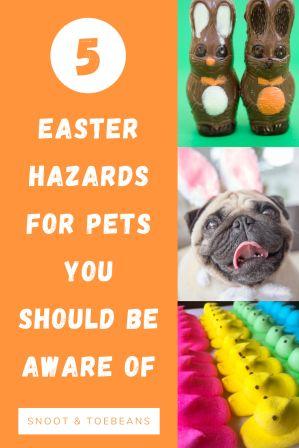
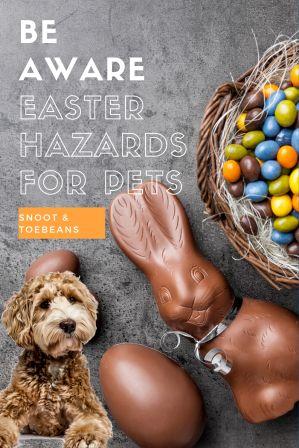



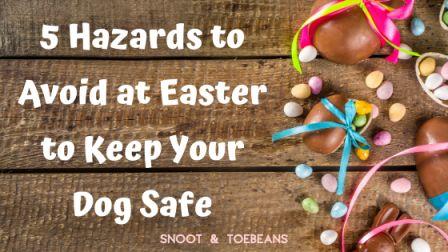
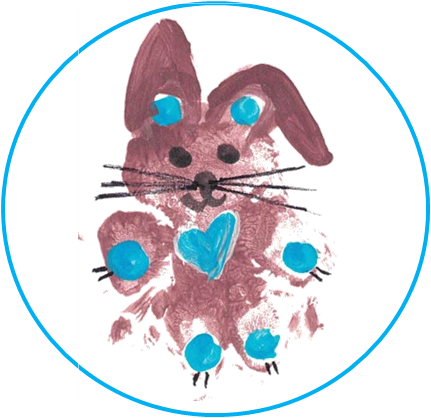
Very interesting, very good job and thanks for sharing such a fantastic blog.
King regards,
Dinesen Valenzuela
Thank you Dinesen.
Pingback: Homemade Dog Treats For Easter | Snoot and Toebeans